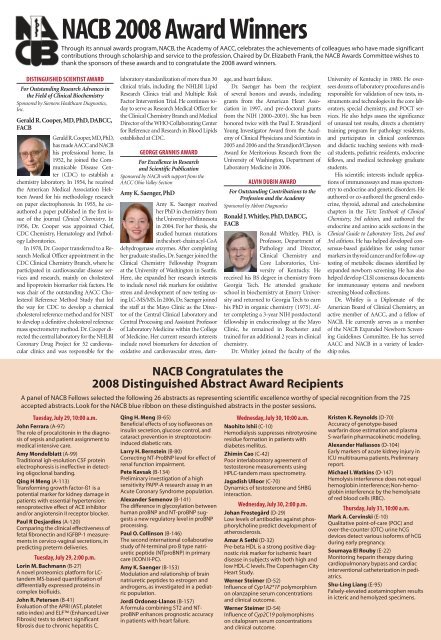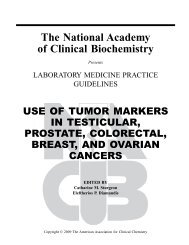Download the Monday Daily - American Association for Clinical ...
Download the Monday Daily - American Association for Clinical ...
Download the Monday Daily - American Association for Clinical ...
Create successful ePaper yourself
Turn your PDF publications into a flip-book with our unique Google optimized e-Paper software.
NACB 2008 Award Winners<br />
Through its annual awards program, NACB, <strong>the</strong> Academy of AACC, celebrates <strong>the</strong> achievements of colleagues who have made significant<br />
contributions through scholarship and service to <strong>the</strong> profession. Chaired by Dr. Elizabeth Frank, <strong>the</strong> NACB Awards Committee wishes to<br />
thank <strong>the</strong> sponsors of <strong>the</strong>se awards and to congratulate <strong>the</strong> 2008 award winners.<br />
DISTINGUISHED SCIENTIST AWARD<br />
For Outstanding Research Advances in<br />
<strong>the</strong> Field of <strong>Clinical</strong> Biochemistry<br />
Sponsored by Siemens Healthcare Diagnostics,<br />
Inc.<br />
Gerald R. Cooper, MD, PhD, DABCC,<br />
FACB<br />
Gerald R. Cooper, MD, PhD,<br />
has made AACC and NACB<br />
his professional home. In<br />
1952, he joined <strong>the</strong> Communicable<br />
Disease Center<br />
(CDC) to establish a<br />
chemistry laboratory. In 1954, he received<br />
<strong>the</strong> <strong>American</strong> Medical <strong>Association</strong> Hektoen<br />
Award <strong>for</strong> his methodology research<br />
on paper electrophoresis. In 1955, he coauthored<br />
a paper published in <strong>the</strong> first issue<br />
of <strong>the</strong> journal <strong>Clinical</strong> Chemistry. In<br />
1956, Dr. Cooper was appointed Chief,<br />
CDC Chemistry, Hematology and Pathology<br />
Laboratories.<br />
In 1978, Dr. Cooper transferred to a Research<br />
Medical Officer appointment in <strong>the</strong><br />
CDC <strong>Clinical</strong> Chemistry Branch, where he<br />
participated in cardiovascular disease services<br />
and research, mainly on cholesterol<br />
and lipoprotein biomarker risk factors. He<br />
was chair of <strong>the</strong> outstanding AACC Cholesterol<br />
Reference Method Study that led<br />
<strong>the</strong> way <strong>for</strong> CDC to develop a chemical<br />
cholesterol reference method and <strong>for</strong> NIST<br />
to develop a definitive cholesterol reference<br />
mass spectrometry method. Dr. Cooper directed<br />
<strong>the</strong> central laboratory <strong>for</strong> <strong>the</strong> NHLBI<br />
Coronary Drug Project <strong>for</strong> 52 cardiovascular<br />
clinics and was responsible <strong>for</strong> <strong>the</strong><br />
laboratory standardization of more than 30<br />
clinical trials, including <strong>the</strong> NHLBI Lipid<br />
Research Clinics trial and Multiple Risk<br />
Factor Intervention Trial. He continues today<br />
to serve as Research Medical Officer <strong>for</strong><br />
<strong>the</strong> <strong>Clinical</strong> Chemistry Branch and Medical<br />
Director of <strong>the</strong> WHO Collaborating Center<br />
<strong>for</strong> Reference and Research in Blood Lipids<br />
established at CDC.<br />
GEORGE GRANNIS AWARD<br />
For Excellence in Research<br />
and Scientific Publication<br />
Sponsored by NACB with support from <strong>the</strong><br />
AACC Ohio Valley Section<br />
Amy K. Saenger, PhD<br />
Amy K. Saenger received<br />
her PhD in chemistry from<br />
<strong>the</strong> University of Minnesota<br />
in 2004. For her <strong>the</strong>sis, she<br />
studied human mutations<br />
in <strong>the</strong> short-chain acyl-CoA<br />
dehydrogenase enzymes. After completing<br />
her graduate studies, Dr. Saenger joined <strong>the</strong><br />
<strong>Clinical</strong> Chemistry Fellowship Program<br />
at <strong>the</strong> University of Washington in Seattle.<br />
Here, she expanded her research interests<br />
to include novel risk markers <strong>for</strong> oxidative<br />
stress and development of new testing using<br />
LC-MS/MS. In 2006, Dr. Saenger joined<br />
<strong>the</strong> staff at <strong>the</strong> Mayo Clinic as <strong>the</strong> Director<br />
of <strong>the</strong> Central <strong>Clinical</strong> Laboratory and<br />
Central Processing and Assistant Professor<br />
of Laboratory Medicine within <strong>the</strong> College<br />
of Medicine. Her current research interests<br />
include novel biomarkers <strong>for</strong> detection of<br />
oxidative and cardiovascular stress, dam-<br />
age, and heart failure.<br />
Dr. Saenger has been <strong>the</strong> recipient<br />
of several honors and awards, including<br />
grants from <strong>the</strong> <strong>American</strong> Heart <strong>Association</strong><br />
in 1997, and pre-doctoral grants<br />
from <strong>the</strong> NIH (2000–2003). She has been<br />
honored twice with <strong>the</strong> Paul E. Strandjord<br />
Young Investigator Award from <strong>the</strong> Academy<br />
of <strong>Clinical</strong> Physicians and Scientists in<br />
2005 and 2006 and <strong>the</strong> Strandjord/Clayson<br />
Award <strong>for</strong> Meritorious Research from <strong>the</strong><br />
University of Washington, Department of<br />
Laboratory Medicine in 2006.<br />
ALVIN DUBIN AWARD<br />
For Outstanding Contributions to <strong>the</strong><br />
Profession and <strong>the</strong> Academy<br />
Sponsored by Abbott Diagnostics<br />
Ronald J. Whitley, PhD, DABCC,<br />
FACB<br />
Ronald Whitley, PhD, is<br />
Professor, Department of<br />
Pathology and Director,<br />
<strong>Clinical</strong> Chemistry and<br />
Core Laboratories, University<br />
of Kentucky. He<br />
received his BS degree in chemistry from<br />
Georgia Tech. He attended graduate<br />
school in biochemistry at Emory University<br />
and returned to Georgia Tech to earn<br />
his PhD in organic chemistry (1975). After<br />
completing a 3-year NIH postdoctoral<br />
fellowship in endocrinology at <strong>the</strong> Mayo<br />
Clinic, he remained in Rochester and<br />
trained <strong>for</strong> an additional 2 years in clinical<br />
chemistry.<br />
Dr. Whitley joined <strong>the</strong> faculty of <strong>the</strong><br />
NACB Congratulates <strong>the</strong><br />
2008 Distinguished Abstract Award Recipients<br />
University of Kentucky in 1980. He oversees<br />
dozens of laboratory procedures and is<br />
responsible <strong>for</strong> validation of new tests, instruments<br />
and technologies in <strong>the</strong> core laboratory,<br />
special chemistry, and POCT services.<br />
He also helps assess <strong>the</strong> significance<br />
of unusual test results, directs a chemistry<br />
training program <strong>for</strong> pathology residents,<br />
and participates in clinical conferences<br />
and didactic teaching sessions with medical<br />
students, pediatric residents, endocrine<br />
fellows, and medical technology graduate<br />
students.<br />
His scientific interests include applications<br />
of immunoassays and mass spectometry<br />
to endocrine and genetic disorders. He<br />
authored or co-authored <strong>the</strong> general endocrine,<br />
thyroid, adrenal and catecholamine<br />
chapters in <strong>the</strong> Tietz Textbook of <strong>Clinical</strong><br />
Chemistry, 3rd edition, and authored <strong>the</strong><br />
endocrine and amino acids sections in <strong>the</strong><br />
<strong>Clinical</strong> Guide to Laboratory Tests, 2nd and<br />
3rd editions. He has helped developed consensus-based<br />
guidelines <strong>for</strong> using tumor<br />
markers in thyroid cancer and <strong>for</strong> follow-up<br />
testing of metabolic diseases identified by<br />
expanded newborn screening. He has also<br />
helped develop CLSI consensus documents<br />
<strong>for</strong> immunoassay systems and newborn<br />
screening blood collections.<br />
Dr. Whitley is a Diplomate of <strong>the</strong><br />
<strong>American</strong> Board of <strong>Clinical</strong> Chemistry, an<br />
active member of AACC, and a fellow of<br />
NACB. He currently serves as a member<br />
of <strong>the</strong> NACB Expanded Newborn Screening<br />
Guidelines Committee. He has served<br />
AACC and NACB in a variety of leadership<br />
roles.<br />
A panel of NACB Fellows selected <strong>the</strong> following 26 abstracts as representing scientific excellence worthy of special recognition from <strong>the</strong> 725<br />
accepted abstracts. Look <strong>for</strong> <strong>the</strong> NACB blue ribbon on <strong>the</strong>se distinguished abstracts in <strong>the</strong> poster sessions.<br />
Tuesday, July 29, 10:00 a.m. Qing H. Meng (B-65)<br />
John Ferrara (A-97)<br />
The role of procalcitonin in <strong>the</strong> diagnosis<br />
of sepsis and patient assignment to<br />
medical intensive care.<br />
Amy Mondelblatt (A-99)<br />
Traditional igh-esolution CSF protein<br />
electrophoresis is ineffective in detecting<br />
oligoclonal banding.<br />
Qing H Meng (A-113)<br />
Trans<strong>for</strong>ming growth factor-ß1 is a<br />
potential marker <strong>for</strong> kidney damage in<br />
patients with essential hypertension:<br />
renoprotective effect of ACE inhibitor<br />
and/or angiotensin II receptor blocker.<br />
Paul R Desjardins (A-120)<br />
Comparing <strong>the</strong> clinical effectiveness of<br />
fetal fibronectin and IGFBP-1 measurements<br />
in cervico-vaginal secretions, in<br />
predicting preterm deliveries.<br />
Tuesday, July 29, 2:00 p.m.<br />
Beneficial effects of soy isoflavones on<br />
insulin secretion, glucose control, and<br />
cataract prevention in streptozotocininduced<br />
diabetic rats.<br />
Larry H. Bernstein (B-80)<br />
Correcting NT-ProBNP level <strong>for</strong> effect of<br />
renal function impairment.<br />
Pete Kavsak (B-134)<br />
Preliminary investigation of a high<br />
sensitivity PAPP-A research assay in an<br />
Acute Coronary Syndrome population.<br />
Alexander Semenov (B-141)<br />
The difference in glycosylation between<br />
human proBNP and NT-proBNP suggests<br />
a new regulatory level in proBNP<br />
processing.<br />
Paul O. Collinson (B-146)<br />
The second international collaborative<br />
study of N-terminal pro B type natriuretic<br />
peptide (NTproBNP) in primary<br />
care (ICON II-PC).<br />
Lorin M. Bachmann (B-27)<br />
A novel proteomics plat<strong>for</strong>m <strong>for</strong> LCtandem<br />
MS-based quantification of<br />
differentially expressed proteins in<br />
complex biofluids.<br />
Amy K. Saenger (B-153)<br />
Modulation and relationship of brain<br />
natriuretic peptides to estrogen and<br />
androgens, as investigated in a pediatric<br />
population.<br />
John R. Petersen (B-41)<br />
Jordi Ordonez-Llanos (B-157)<br />
Evaluation of <strong>the</strong> APRI (AST, platelet A <strong>for</strong>mula combining ST2 and NT-<br />
ratio index) and ELF (Enhanced Liver proBNP enhances prognostic accuracy<br />
Fibrosis) tests to detect significant<br />
14 CliniCal laboratory news Special edition in patients with heart failure.<br />
fibrosis due to chronic hepatitis C.<br />
Wednesday, July 30, 10:00 a.m.<br />
Naohito Ishii (C-10)<br />
Hemodialysis suppresses nitrotyrosine<br />
residue <strong>for</strong>mation in patients with<br />
diabetes mellitus.<br />
Zhimin Cao (C-42)<br />
Poor interlaboratory agreement of<br />
testosterone measurements using<br />
HPLC-tandem mass spectrometry.<br />
Jagadish Ulloor (C-70)<br />
Dynamics of testosterone and SHBG<br />
interaction.<br />
Wednesday, July 30, 2:00 p.m.<br />
Johan Frostegård (D-29)<br />
Low levels of antibodies against phosphorylcholine<br />
predict development of<br />
a<strong>the</strong>rosclerosis.<br />
Amar A Sethi (D-32)<br />
Pre-beta HDL is a strong positive diagnostic<br />
risk marker <strong>for</strong> ischemic heart<br />
disease in subjects with both high and<br />
low HDL-C levels. The Copenhagen City<br />
Heart Study.<br />
Werner Steimer (D-52)<br />
Influence of Cyp1A2*1F polymorphism<br />
on olanzapine serum concentrations<br />
and clinical outcome.<br />
Werner Steimer (D-54)<br />
Influence of Cyp2C19 polymorphisms<br />
on citalopram serum concentrations<br />
and clinical outcome.<br />
Kristen K. Reynolds (D-70)<br />
Accuracy of genotype-based<br />
warfarin dose estimation and plasma<br />
S-warfarin pharmacokinetic modeling.<br />
Alexander Haliassos (D-104)<br />
Early markers of acute kidney injury in<br />
ICU multitrauma patients. Preliminary<br />
report.<br />
Michael I. Watkins (D-147)<br />
Hemolysis interference does not equal<br />
hemoglobin interference; Non-hemoglobin<br />
interference by <strong>the</strong> hemolysate<br />
of red blood cells (RBC).<br />
Thursday, July 31, 10:00 a.m.<br />
Mark A. Cervinski (E-10)<br />
Qualitative point-of-care (POC) and<br />
over-<strong>the</strong>-counter (OTC) urine hCG<br />
devices detect various iso<strong>for</strong>ms of hCG<br />
during early pregnancy.<br />
Soumaya El Rouby (E-22)<br />
Monitoring heparin <strong>the</strong>rapy during<br />
cardiopulmonary bypass and cardiac<br />
interventional ca<strong>the</strong>terization in pediatrics.<br />
Shu-Ling Liang (E-95)<br />
Falsely-elevated acetaminophen results<br />
in icteric and hemolyzed specimens.
















